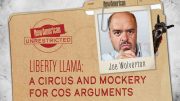
The day after retired Supreme Court Justice John Paul Stevens called for repeal of the Second Amendment back in March, President Trump tweeted: “THE SECOND AMENDMENT WILL NEVER BE REPEALED! As much as Democrats would like to see this happen, and despite the words yesterday of former Supreme Court Justice Stevens, NO WAY.”
On Tuesday, Trump’s acting Attorney General Matthew Whitaker said “WAY” by announcing the final rule from the Bureau of Alcohol, Tobacco, Firearms and Explosives (ATF) banning so-called bump stocks. He announced the agency’s rule by claiming that it was an “amendment” of an existing rule and not a new ruling per se and therefore didn’t need Congressional approval:
The Department of Justice is amending the regulations of the Bureau of Alcohol, Tobacco, Firearms, and Explosives (ATF) to clarify that bump-stock-type devices — meaning “bump fire” stocks, slide-fire devices, and devices with certain similar characteristics — are “machineguns” as defined by the National Firearms Act of 1934 and the Gun Control Act of 1968 because such devices allow a shooter of a semiautomatic firearm to initiate a continuous firing cycle with a single pull of the trigger….
The bump-stock-type devices covered by this final rule … will be prohibited when this rule becomes effective [estimated to be March 21, 2019].
A senior official from the Department of Justice made clear that they intended to allow the ATF to enforce the law with every asset they had: “We anticipate that the general public will be compliant with the law. To the extent someone chooses not to comply with the law, we will treat this as we do with all firearms offenses. We will prioritize our resources to maximize public safety, focusing on those that pose the greatest threat. We will enforce the statute based on the circumstances of the individual case as we do with all firearms law.”
There are so many problems with the new “amendment” of existing law that complaints and lawsuits by pro-Second Amendment groups have already been filed.
The first problem isn’t with the president’s apparent hedging on his self-proclaimed undying support for the Second Amendment. It’s with the Amendment itself: “A well-regulated Militia, being necessary to the security of a free State, the right of the people to keep and bear arms, shall not be infringed.”
It’s that word “infringe” that creates the problem with this “final rule”. Infringe is defined by the Cambridge English Dictionary as “to act in a way that is against the law or that limits someone’s right or freedom.” The Legal Dictionary expands the definition so that no one may misunderstand what the Founders intended:
Infringe (a verb): abuse a privilege, abuse one’s rights, advance stealthily, aggress, arrogate, breach, break, break bounds, break in upon, break into, commit a breach, impinge, impose, infract, interfere, interlope, invade, meddle, overstep, seize wrongfully, take liberties, transgress, trespass, use wrongfully, usurp, violate, violate a contract, violate a law, violate a privilege [or] violate a regulation.
It doesn’t matter that there are only about 500,000 bump stocks owned by American gun owners, and so therefore such a “final rule” can be safely ignored by the rest of them. What matters is the precedent it sets if the “final rule” becomes operative in March. If the ATF can arbitrarily declare that bump stocks turn semi-automatic weapons into “machine guns” and therefore fall under the NFA (National Firearms Act of 1934) and the GCA (Gun Control Act of 1968) prohibitions, then what’s to keep them from finding some way to turn semi-automatic rifles and pistols into illegal firearms under those laws as well?
When the initial rule was opened for public comment last spring, the NRA-ILA commented on some of its many flaws. First, Congress (not the ATF) defined the definition of a “machinegun” as “any weapon which shoots, or is designed to shoot, or can be readily restored to shoot, automatically more than one shot, without manual reloading, by a single function of the trigger.” So, claimed the NRA, only Congress can change that definition, not the ATF.
Second, that law “sets forth a mechanical test, not a performance-based standard [which instead] focuses on the rate of fire.” Thirdly, this new definition reverses years of rulings by the ATF that specifically claimed that bump stocks didn’t convert semi-automatic firearms into “machineguns.” Said the NRA, “Unmodified semi-automatic firearms have never been considered ‘machineguns’ for purposes of federal law.”
The NRA saw the danger of allowing this arbitrary and capricious ruling to stand: “However ATF proceeds with this rulemaking, it is important that the distinction between semiautomatic firearms and machineguns remains clear. There are tens of millions of semiautomatic firearms currently possessed by law-abiding Americans. Suddenly and retroactively banning them as “machinegun[s]” under federal law would create a number of very serious constitutional, legal, and practical problems.”
A lawsuit filed by three pro-Second Amendment groups in California complained that “ATF’s abrupt about-face on this issue … smacks of agency abuse … in following the law.” It cited a court ruling from 1983 stating that “a sudden and profound alteration in an agency’s policy constitutes [a] ‘danger signal’ that the will of Congress is being ignored.”
The complaint added:
The Final Rule would violate fundamental constitutional protections against retroactive imposition of criminal punishment under ex post facto principles….
What is more, in connection with its failure or refusal to provide for the proper form of public discourse before adopting the Final Rule (as one of the many ways in which the ATF flouted the requirements of the Administrative Procedures Act) the ATF failed or refused to respond to Plaintiff’s valid request for pertinent information under the Freedom of Information Act (FOIA).
In other words, the complaint charges the ATF with deliberate reluctance to provide the requested documentation on how the agency decided to reverse its decades-long definition concerning bump stocks.
If the Final Rule becomes law in March, the question of its enforcement must be addressed. When DOJ officials were asked directly just how they would enforce it, they responded: “We have no plans to go door to door nor do we have the resources. The Department of Justice primarily relies on voluntary compliance by citizens. Most firearms owners are law-abiding citizens. We anticipate compliance with the law. Those who choose not to comply with the law we will investigate on a case-by-case basis. There is not a blanket plan here.”
That anticipation of voluntary compliance is likely misplaced. When New Jersey anti-gun lawmakers passed a law banning possession of bump stocks in January, their owners were given until the middle of April either to destroy them or to turn them in to authorities. As of early May not a single one had been turned in according to the New Jersey State Police. The concerned lawmakers of New Jersey also passed a “high-capacity” (over 10 rounds) magazine ban in June, and as of December 11, none have been turned in. Apparently, New Jersey’s one-million-plus gun owners don’t own any bump stocks or high-capacity magazines!
The New American reported on the reluctance of law-abiding gun owners to follow similar laws enacted by “the People’s Republic of Boulder,” Colorado. Gun owners in Boulder were estimated to have 150,000 now-illegal “assault weapons,” “high-capacity” magazines and “bump stocks” in their possession. To take advantage of the law’s grandfather clause, those owners had until December 27 this year to get them certified by local police. As of December 1, the Boulder Police Department reported that they had certified just 85 of them.
The ATF under Trump is just begging for a fight by poking law-abiding gun owners in the eye with arbitrary and illegal redefinitions of what’s legal and what’s not. If the Final Rule goes into effect in March, gun owners see the problem: If this rogue agency can, on its own, declare bump stocks to be illegal, what’s to keep this same agency from declaring all semi-automatic weapons illegal as well? That would, as the NRA correctly noted above, “suddenly and retroactively … create a number of very serious constitutional, legal, and practical problems.” (Emphasis added.)
Photo: AP Images
An Ivy League graduate and former investment advisor, Bob is a regular contributor to The New American magazine and blogs frequently at LightFromTheRight.com, primarily on economics and politics. He can be reached at [email protected].
Related article:




